Latest Blogs
Software Development
Ramsha Khan
Dec 11, 2025

How DevOps Improves Compliance in Regulated Industries ...
In industries where regulations are strict and audits are routine, compliance isn’t optional; it’s mission-critical. Whether you’re in healthcare, finance, or any other tightly governed sector, meeting regulatory standards like HIPAA, PCI-DSS, or GDPR can be daunting. Traditionally, compliance meant red tape, delays, and siloed workflows. But DevOps is turning that on its head.
Today, we’ll explore how DevOps improves compliance in regulated industries, introduce best practices, and explain how Arpatech helps organizations navigate the tricky waters of regulatory demands while accelerating innovation.
DevOps seems to be quite an offbeat from other aspects of the world. It flips compliance almost upside-down by speed, iteration, and collaboration. But in reality, they’re truly melded at the hip.
All features of DevOps automation, visibility, and ongoing monitoring are harmonious with the requirements of compliance frameworks for extensive audit trails, regular verification, and swift rebuttal to vulnerabilities.
Here is why:
If anything, DevOps in regulated sectors is about incorporating compliance into the software delivery pipeline; not about flouting rules. So how does that work?
Security is considered from the beginning. Compliance checks happen at every stage of development instead of being bolted on at the end.
At CI/CD pipeline level compliance rules are enforced. In such scenarios, the pipeline could be configured to prevent deployment if any or all compliance checks have not passed.
Like infrastructure, compliance requirements are also written in code, which gives you version control, testing, and repeatability.
To thrive in a regulated environment, it’s not enough to just “do DevOps.” You need remember all the DevOps best practices and here are some DevOps compliance best practices that can help:
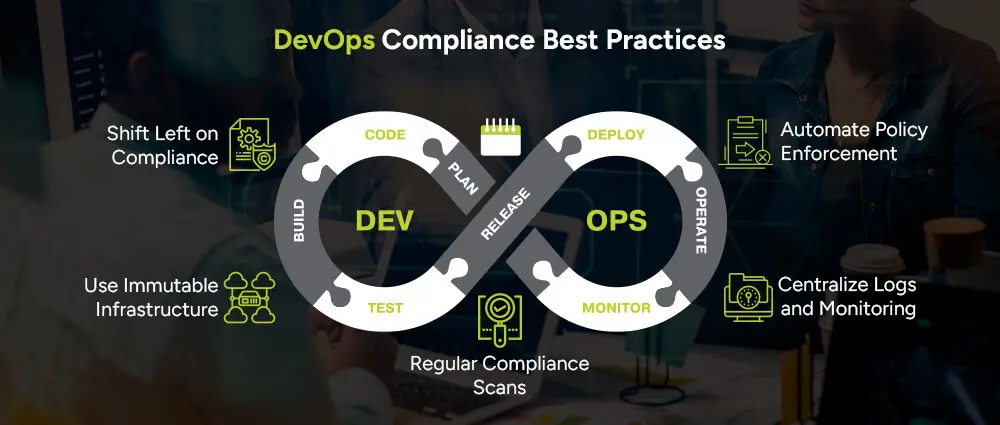
Bring compliance early into the development lifecycle. This avoids costly rework and ensures regulatory standards are considered from day one.
Use tools that automatically enforce security and compliance policies. For instance, code that doesn’t meet encryption standards can be flagged immediately.
Once a server or environment is created, it should never be changed manually. Instead, any changes should be made through code. This provides an auditable trail of changes.
All activity logs should be collected in a central location, where they can be analyzed and audited. This is vital for post-incident reviews and proving compliance.
Schedule scans for vulnerabilities, policy violations, and security misconfigurations. Many tools support this natively within the CI/CD pipeline.
DevSecOps is DevOps with security and compliance built-in. In regulated industries, it’s non-negotiable.
Healthcare organizations need to comply with regulations like HIPAA. This means protecting patient data, ensuring uptime, and keeping audit trails.
Example: A hospital using Arpatech’s DevOps services automated its deployment process while ensuring all PHI (Protected Health Information) handling followed HIPAA protocols.
The financial sector deals with PCI-DSS, SOX, and other frameworks. DevOps helps by:
Case Study: Arpatech helped a digital banking client implement a secure CI/CD pipeline where compliance checks were part of every commit and deployment.
Here are some common regulations and how DevOps addresses them:
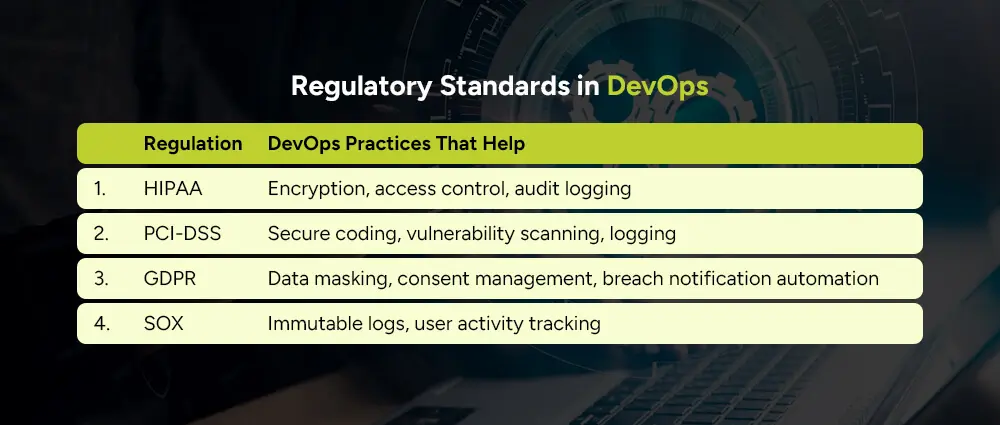
These standards may vary by region and industry, but DevOps’ flexibility allows you to implement controls specific to each requirement.
At Arpatech, we understand that every regulated industry has unique compliance challenges. Our DevOps consulting and implementation services are tailored to align with regulatory frameworks while maintaining speed and agility.
Imagine if a health-tech startup approaches Arpatech to modernize their development workflows while remaining compliant with HIPAA. Here’s how we can help:
How will we be able to solve the issue?
A secure, compliant, and fast-moving release pipeline that passes audits with minimal disruption.
In today’s fast-paced digital landscape, regulated industries don’t have to choose between speed and compliance. With the right DevOps compliance practices in place, your business or start up can have both.
Whether you’re in healthcare, finance, or another regulated sector, integrating DevOps isn’t just a tech upgrade, it’s a compliance game-changer. If you follow all key trends of Devops As a Service, you’ll be able to succeed in no time/
Partner with Arpatech to implement scalable, secure, and regulation-ready DevOps solutions that make compliance a breeze.
DevOps compliance is meant to infuse regulatory, legal, and security standards into the complete DevOps lifecycle. Every software update or infrastructure change should conform to compliance requirements that are relative to their industry.
DevOps fosters improvement in quality, since continuous integration and testing helps to catch problems early. Automated pipelines ensure builds are always consistent and work is collaborative across teams, which prevents misunderstandings, thus producing more stable software, with more security.
Compliance as code turns compliance policies into machine-readable code that can be tested, version-controlled, and enforced automatically. In a DevSecOps model, this ensures compliance is always up-to-date and integrated directly into the development pipeline.
The primary purpose is to ensure that regulatory and security standards are met without slowing down the software delivery process. It enables teams to move fast while staying within the bounds of required laws and frameworks.
Ramsha Khan
Jul 31, 2025

DevOps Best Practices for Remote Engineering Teams in 2...
The way we build, deliver, and maintain software has changed drastically in the last few years. As companies increasingly embrace remote and hybrid work models, remote collaboration in DevOps has become the backbone of distributed engineering teams. By 2025, new advancements, ranging from AI-powered automation to zero-trust security, are reshaping the way DevOps for hybrid and remote teams operates.
Today, we are diving deep into the tools and best practices for remote DevOps, exploring how organizations can maintain collaboration, culture, and efficiency while managing distributed teams.
Talking about how remote engineering teams now have DevOps practices, we need to go back and at least learn a bit about DevOps first.
So, What is DevOps?
DevOps is more than a set of business intelligence tools for Startups; it’s a cultural and technical approach that combines software development (Dev) and IT operations (Ops) to deliver software faster, with higher quality and greater reliability.
DevOps culture accentuates collaboration, automation, continuous integration (CI), continuous delivery (CD), and shared ownership. In 2025, cloud-native DevOps transformed this culture, allowing distributed teams to manage infrastructure, deploy updates, and live up to customer expectations.
The fundamental areas of remote software delivery methods for teams are:
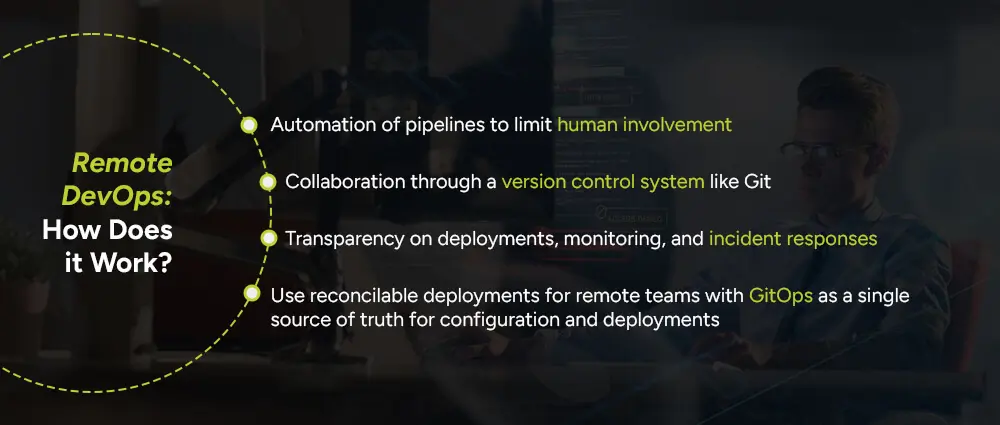
The pandemic fast-tracked the transition to DevOps management from anywhere, which has now become all too common in 2025 for various engineering teams. Remote DevOps integrates cloud-native platforms, CI/CD for distributed teams, and collaboration tools that facilitate asynchronous work.
While managing DevOps teams remotely offers flexibility, global reach, and access to diverse talent, it also comes with a unique set of challenges that organizations need to address carefully:
When people come from different parts of the world or time zones, it becomes a challenge for them to be on the same page. Misunderstandings or delays in sharing information further could pose issues within the development cycle, missed deadlines, and even critical errors. Clear and consistent communication gets more important than ever before.
The very nature of remote working environments tends to increase the number of points of entry for possible cyber threats. Employees are likely to connect to the organization from some unsecured network or personal devices, and such use exposes the system to breaches. That calls for a ‘zero-trust’ security model, where no device or user comes trusted by default, so that data and systems are kept secure.
Remote teams often use a variety of tools for development, communication, testing, and deployment. When these tools fail to connect or share information effectively, it creates silos, isolated systems that don’t communicate with each other. This can slow down workflows and lead to confusion or duplication of work.
The fast response to system failure or outages is an important part of DevOps. However, it’s hard to schedule on-call time for groups across time zones and respond quickly. Fast and smooth remote incident response coordination therefore requires clear protocols and, whenever possible, automation.
Building and sustaining an effective DevOps culture in a remote team is among the most unappreciated challenges. Daily face-to-face interaction keeps the fire of spirit, values, and collaboration going. Leaders need to be intentional in creating bonded people who recognize each other and have some common goals.
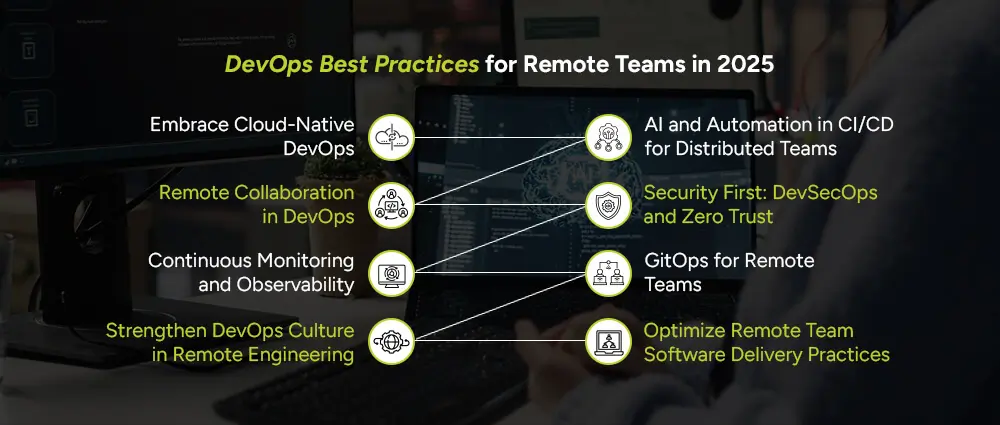
To tackle these challenges, companies must adopt modern DevOps strategies and collaboration tools that keep distributed teams aligned and productive,. These are known as DevOps best practices, which are:
In 2025, cloud-native DevOps will rely on containerization, microservices, and serverless architectures. Kubernetes, AWS EKS, and Azure AKS help teams deploy applications globally, which ensures low latency and high availability for end users.
Significance:
Automation is the foundation of in-house or outsourced DevOps as a service. In 2025, AI has supercharged CI/CD pipelines, enabling predictive analysis, faster deployments, and self-healing systems.
Best practices:
To have remote collaboration on DevOps, a proper way must be employed to communicate as well as track projects. Nowadays, Slack or Microsoft Teams, and Zoom are directly being integrated into CI/CD pipelines or ChatOps for real-time updates.
Best Practices:
Security should not be an afterthought, particularly when considering remote teams. The adoption of DevSecOps services assures that security gets consideration in the early stages of the software development life cycle.
Best practices include:
Being remote means that visibility is important for DevOps. Continuous monitoring and observability tools like Datadog, Prometheus, and Grafana enable teams to track performance and identify issues before they arise.
Best practices include:
GitOps have become the highest standard for the management of infrastructures and deployments. Using Git repositories as the single source of truth affords the remote team to confidently deploy changes.
Best practices:
Cultural alignment is very important for success in the remote setting. In enhancing the DevOps culture in remote engineering, the best practices that we should adapt are:
For remote team software delivery practices, focus on small, frequent releases rather than large, risky deployments.
To ensure that managing DevOps remotely is seamless, teams must adopt the right toolchain.
Must-have categories:
To evaluate how effective the teams have been, the following metrics should be monitored:
The future of remote collaboration in DevOps is being shaped by AI, automation, and decentralized technologies. Expect to see:
Managing DevOps remotely, from this point on, is a permanent phenomenon. Companies are thriving in a distributed work environment by implementing DevOps best practices for remote teams; relying on key trends of remote DevOps as a service collaboration tools; and building a culture of transparency and automation.
Remote teams’ software building and delivery activities are being transformed by cloud-native DevOps 2025, AI-enabled CI/CD pipelines, and GitOps. If organizations truly make investments in remote software delivery practices and the right toolchain, they will not just keep pace with these advancements, but, instead, will lead the path into the future of digital innovation.
Are you ready to future-proof your engineering teams, then? Implement these immediately with Arpatech for remote DevOps services to deliver software in 2025-Faster, Safer, and Smarter.
DevOps, in its core aspect, is the simultaneous existence of four key principles:
An introduction to the 7 principles of DevOps:
Ramsha Khan
Jul 29, 2025

How Much Does It Cost to Build an App in 2025?
Thinking about launching your own app in 2025? Whether it’s the next health-tracking revolution or an e-commerce game-changer, one question is bound to come up early: How much does it cost to build an app in 2025?”
The honest answer? It depends.
App development cost varies significantly based on multiple factors, ranging from the type of app you want to build, to its complexity, features, the development platform, and even the country your development team is based in.
Let’s break it all down so you get a clearer picture, without diving into confusing price tags or hard numbers.
Before we talk about actual budgets, it’s important to understand what affects app development costs. Imagine building an app like building a house, you wouldn’t expect the cost to be the same for a cozy cottage and a luxury villa, right?
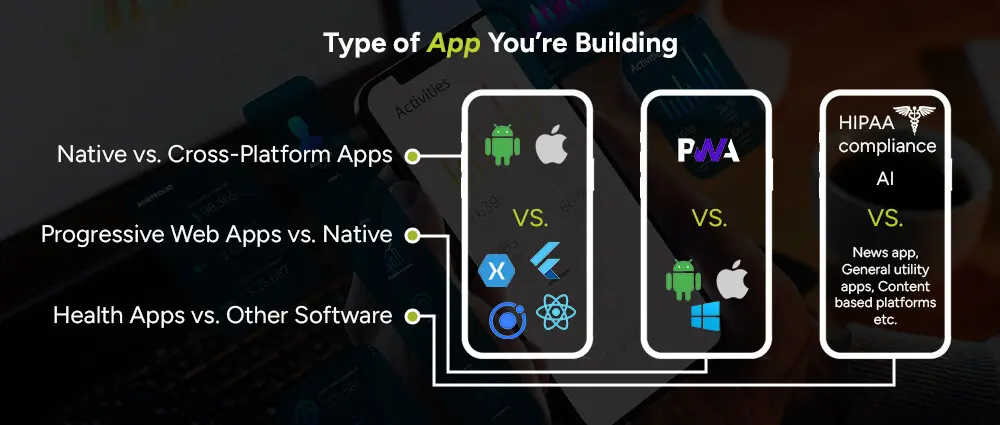
Native applications are typically designed for one specific platform, whereas cross-platform applications are supported on both the platforms mentioned above. Generally, native applications will provide better performance and experience, but they take more time to develop.
In short, a cross-platform application shares a single code base for both platforms. They take a shorter time to develop and lower costs, but perhaps sacrificing a little bit more on the performance or user customization.
Progressive Web Applications are mobile-optimized websites, which are cheaper to build and maintain. They are quite interesting for businesses looking to have a presence without actually going through all the processes of developing a fully mobile application. Native applications will be better suited for full-feature experiences such as ride-hailing, gaming, or health tracking.
Health apps usually need real-time data, wearables integration, strong security like HIPAA compliance, and sometimes even AI.
That makes them more complex, and more expensive, than, say, a to-do list or a news app. These add to the app development cost compared to simpler utility apps or content-based platforms.
Different industries have different app requirements. For example:
Each of these business types affects how much it costs to build your app, depending on the features and security level required.
The more complex your app, the more time and effort it takes to build.
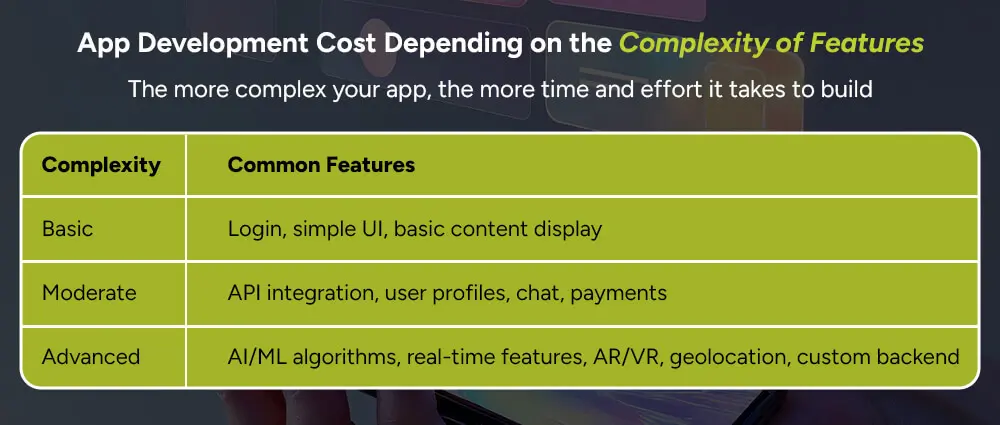
Even features that seem simple, like push notifications or login with Google/Facebook, can add time and cost.
The entire development procedure is subdivided into various stages. Each of them has its associated cost:
Additionally, the costs that are also associated with development must follow every stage: Strategy & Planning-in defining goals, audience, and features; UI/UX Design-in defining looks, feels, and experience; Development coding on front and back ends; Testing & QA-in catching bugs and ensuring all devices work with the app, and Deployment-publishing on the app stores.
Post-launch support: updates, patches, and new features. Of course, don’t forget software licensing, third-party services-for example, Google Maps and payment gateways, as well as cloud infrastructure, all of which impact final app development cost.
While budgeting, it’s easy to focus only on design and coding. But watch out for these hidden costs:
These elements are essential if you want your app to perform well and reach your target audience.
Once your app is live, the work isn’t over. Apps need regular updates to stay compatible with new OS versions, fix bugs, and introduce new features. These app maintenance costs are ongoing but crucial.
You might also need ongoing customer support, especially if your app offers real-time services or e-commerce functionality.
There is no need to put everything on the line for the first go. Here’s how to be sensible:
Take note of the MVP (Minimum Viable Product): Create only the important features to test your idea with feedback from users.
There are also some app development cost calculators online to give rough estimates based on requirements, but take these as guide figures, not as fixed quotations.
As mentioned, different industries and platforms come with different cost expectations:
Also, industry-specific needs like data security in finance or real-time tracking in logistics play a huge role in pricing.
The location of your development team significantly affects your overall cost.
We take application development very seriously at Arpatech. Scalable, secured, and high-performance applications that suit your specific needs are what we implement here. Put your best foot forward with our clear and flexible processes. We also offer the option to either build an MVP or create a full-featured application from day one. Our applications are feasibly strategically planned, expertly developed, and continuously supported to turn into prodigious success above cost.
According to Gartner-backed surveys from global development firms, businesses are increasingly moving toward hybrid models and MVP-first approaches in 2025 to manage app development costs better. The focus is now more on long-term sustainability than one-time launches.
When it comes to figuring out how much it costs to develop an app in 2025, clarity and planning are key. Costs will vary, but with the right team, approach, and strategy, your app can be both affordable and powerful.
If you’re ready to explore possibilities, get in touch with Arpatech today. We’ll help you bring your idea to life, one smart step at a time.
When it comes to development, the size of the app, its feature set, and the team working on it all come into play. A small app would, therefore, be affordable, while an app with an extensive set of integrations and an elaborate feature set may incur considerable costs. We suggest that you start with something small and scale it up.
It’s not an easy question to answer. Freelancers may be less expensive in the short-term, but professional app development agencies have the experience in planning, security, and long-term support. When weighing your options, think quality and trust, not just price.
Definitely, if you have clarity on the purpose, know your target audience well, and propose a solid value proposition. Whether for branding, customer connection, or launching a new business, a well-built app in 2025 can be a game-changer.
Ramsha Khan
Jul 22, 2025

How to Integrate AI into Your Mobile App
2025 is the year of Artificial Intelligence; not only are we past the chatbot era, but we are now seeing AI control all sectors of life. Behind the scenes, it’s powering all the apps you use every day, from music apps like Spotify recommending your next favorite song to Google Maps predicting the fastest route, or your favorite shopping app suggesting exactly what you need before you even search for it.
This is AI in action.
Now back to the business or startup weighing the pros and cons of AI for mobile app development. You sure are not on your own. Many companies these days are asking, How might we use AI to distinguish ourselves, delight our users, and generate real value?
Today, we will look at everything about AI for mobile apps, from the theory and feature ideas, examples from real life, to the best practices.
Let us get to it so we can start applying AI to your next mobile app.
Before looking into the how, let’s first start with the what.
So, the question should be:
What is AI integration for SaaS applications and mobile apps?… and it’s benefits:
AI integration is embedding AI abilities-such as machine learning, natural language processing, image recognition, or predictive analytics-into your application so it can carry out activities requiring human intelligence.
The benefits, especially in SaaS and mobile applications, are huge.
That is why companies should use AI integration in software application development; this is becoming the standard and not an exception.
If you’re wondering whether or not you really need AI in your app, the answer depends on your goals. But here’s the truth: AI isn’t just for tech giants anymore. It’s accessible, affordable, and in many cases, essential for staying competitive.
Here’s why businesses choose to integrate AI in mobile app development:
In fact, one of the strongest benefits of AI in mobile app development is its ability to unlock hyper-personalization and predictive features that directly increase user retention.
So, what exactly can AI do for your mobile app? Let’s explore some AI use cases for apps across industries:
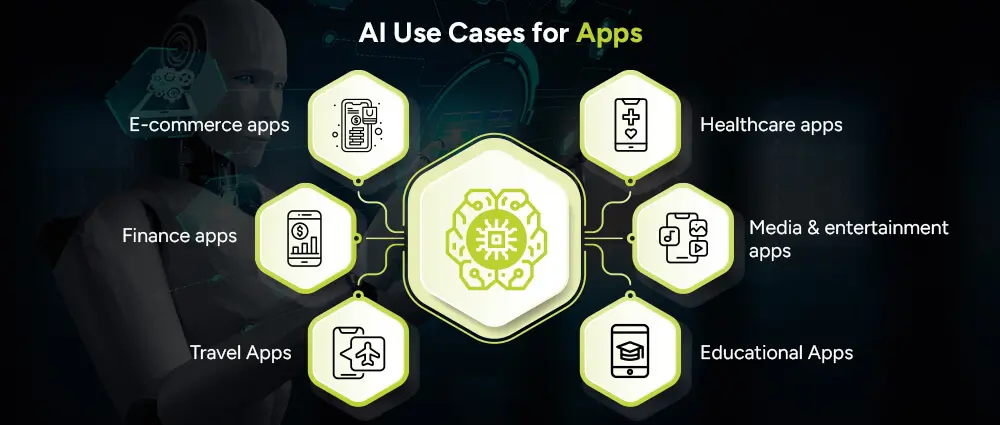
Personalized product recommendations, smart search, visual shopping (you only need to upload a photo and find similar products). These AI apps for e-commerce and businesses are transforming shopping experiences from one-size-fits-all to deeply tailored.
Symptom checkers, predictive health alerts, patient chatbots. This trend is shaping the future of healthcare mobile app development worldwide.
Fraud detection, spending insights, and robo-advisors are common features powered by AI. This ties closely with what is FinTech app development, which increasingly relies on AI for smarter, safer, and more efficient digital finance.
Personalization of playlists, AI content moderation, and smart editing abilities are the tools used to shape user experiences in media and entertainment. From recommendation engines at Netflix to For-you pages on TikTok, AI has been at the core of almost all entertainment apps today.
Modern AI Apps allow travel apps to predict user needs, thus providing highly personalized journeys and trouble-free experiences. Dynamic pricing engines, predictive route planning, and voice-enabled booking assistants stand in good stead to save the traveler time and money.
Personalized education is a term in which Intelligent Tutoring Systems, Automated Grading, and Adaptive Learning Routes take learners closer to distant learning. It modifies education according to students’ strengths and weaknesses such that there is an individualized learning path, one that really fits with every individual.
The AI in this case is the app’s brain from where it gradually learns from users and adapts itself to make more intelligent experiences.
Now let’s get practical. Here’s a step-by-step guide on how to integrate AI into your mobile app.
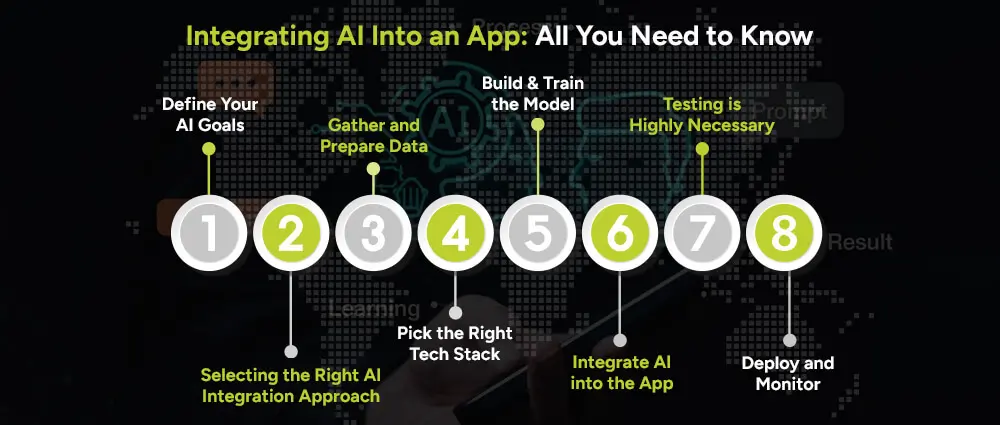
Instead of just thinking about adding AI to your app and business, start with What problem do I want AI to solve?
For example, if you’re building a shopping app, your goal might be Use AI to recommend the right product to the right customer.
This clarity will guide every decision.
There are two main approaches:
Plenty of these ready-to-use services available from different providers such as Google ML Kit, IBM Watson, and Microsoft Azure are quicker, cheaper, and suitable for common tasks such as chatbots, voice recognition, or image tagging. That’s what is known as AIaaS or Artificial Intelligence as a Service, in which businesses tap into cloud-based AI and do not have to reinvent the wheel every single time.
Building your own AI from scratch or training a model on your own data. This is time- and resource-consuming, but gives you total control and differentiation.
Choosing between the two is dictated by considerations of budget, purpose, and timeline.
AI is only as smart as the data it learns from. You need to collect high-quality, relevant data (e.g., purchase history, user activity, images), Clean and organize it so the AI can learn patterns without noise.
For example, Netflix’s recommendation engine works because it analyzes millions of viewing habits to predict what you’ll watch next.
For implementing AI in the next mobile application, the right tools are necessary. Some of the popular frameworks are:
You’ll also want to consider using a cross-platform app framework if you plan to build for both iOS and Android while keeping development costs efficient.
If you’re creating a custom AI model, you are required to:
This ensures your app’s AI doesn’t just work in theory but actually delivers results.
Now, it’s time to merge the AI with your app.
AI isn’t a one-and-done feature. Here are some ways you need to test the Artificial Intelligence in your software:
Just remember, AI improves with iterations. More improvements mean better AI apps.
Once live, monitor AI performance continuously.
AI is dynamic, it learns and adapts, but only if you monitor it closely.
Let’s bring this to life with some examples of AI integration in apps:
Customized shopping experience made possible through artificial intelligence. Amazon uses machine learning algorithms to recommend products based on browsing history, purchasing behavior, and even what is trending among similar demographics. With visual search options such as those provided by ASOS, users can upload an image and immediately locate matching products.
AI forms the core of banking and financial apps, ensuring transparency and customer service. PayPal and Revolut apply AI algorithms to detect fraudulent activity in real time.
Streaming platforms thrive on AI recommendations. For Netflix and Spotify, AI analyzes user behavior and preferences to create personalized playlists or film suggestions and even predicts the content a user will enjoy next.
These examples illuminate AI app integration that generates value across industries. Indeed, if you consider brands converging on retail and e-commerce using AI, you will see similar trends whereby AI directly shapes business outcomes.
These examples show how AI integration in apps creates value across industries. In fact, if you look at brands converging AI into retail and e-commerce, you’ll see similar trends where AI is directly shaping business outcomes.
Of course, integrating AI isn’t always smooth sailing. Some of the major challenges in integrating AI into apps include:
The good news is that these challenges can be overcome with the right foresight, partners, and best practices.
The increasing popularity of mobile application development services has now landed in the fact that businesses are investing in AI-first designs. There is much realization amongst businesses, especially small- to mid-sized companies, about why SMBs need a mobile app that can learn, adapt, and change with the time.
And if you’re brainstorming mobile app ideas for 2025, consider building with AI at the core. Whether it’s retail, fintech, healthcare, or entertainment, AI-driven apps will dominate the landscape.
In the present day, AI is no longer considered an option but an essential part of mobile app development. Master the integration of AI into your mobile app, and that would take your app in giving smarter, faster, more personalized experiences for users.
The roadmap is clear: defining goals, selecting the right strategy, overcoming challenges, and following the best practices. The only question that remains is: “When would you start with integrating AI into your app?”
Have a consultation with mobile App developers at Arpatech, and let’s work together to integrate AI in your business application.
AI-based mobile apps operate algorithms and models that imitate human intelligence. These models process data such as image, voice, or user behavior; learn these patterns; and predict or decide outcome. AI can be exemplified in language learning apps that listen to the user’s pronunciation and give feedback instantaneously.
The assistance of AI is twofold:
Ramsha Khan
Jul 19, 2025

How Managed IT Services Are Shaping the Future of Suppo...
At present, no matter if you’re operating startups or enterprise-level organizations, you can’t afford to fall behind when it comes to technology. With increasing cyber threats, evolving customer expectations, and rapidly changing tech landscapes, businesses need more than just a break-fix IT solution. They need a proactive, strategic partner. That’s where Managed IT Services Support comes in.
Today, we are exploring how Managed IT Services are revolutionizing tech support, the emerging trends in managed IT, and what the future outlook looks like as we head into 2025 and beyond.
Gone are the days when IT support only showed up when something broke. Traditional models worked on a break-fix system, waiting for issues to happen, then trying to fix them. But that’s like only seeing a doctor when you’re really sick, instead of going for regular checkups to prevent problems in the first place.
Managed IT Services Support flips this model on its head by offering proactive IT support. This means continuous monitoring, real-time threat detection, preventive maintenance, and round-the-clock support that helps companies avoid downtime, data loss, and costly repairs.
This proactive approach is not just beneficial, it’s becoming essential.
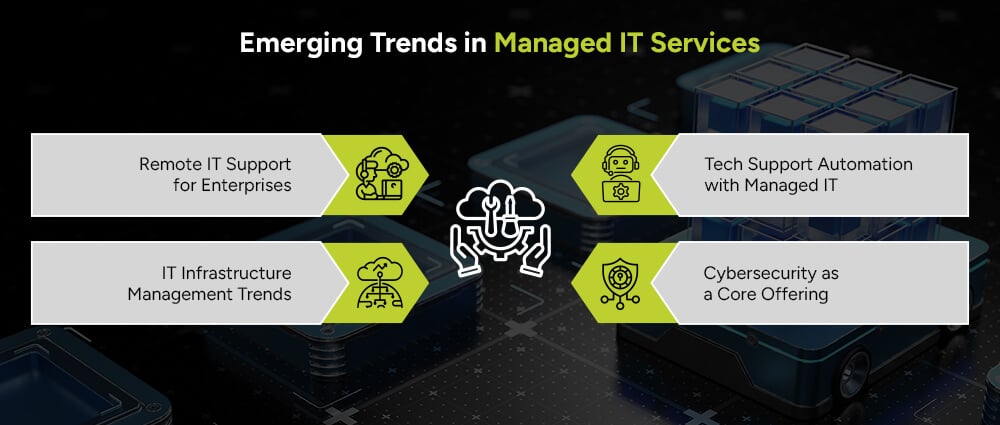
Let’s take a look at what’s shaping the future:
It is now a permanent feature, and has moved over from the pandemic to the present. The most common use of such services for enterprises is the availability of remote managed IT support teams, whereby issues are resolved from anywhere, anytime.
Thanks to faster internet, cloud-based tools, and advanced monitoring software development trends, tech providers can troubleshoot without being on-site.
Help desk experience revolutionized by AI and automation. It now allows automated processing of simple requests such as password resets and system updates to free the technician from simple stuff in order to process more complex cases.
Automated patch management, systems alerts and part of this new breed chatbots comprise this new wave.
Modern businesses run on hybrid infrastructures, part on-premise, part cloud. Managing this mix is becoming a top priority. Managed IT providers are focusing on integrated dashboards, performance analytics, and smarter infrastructure monitoring tools to simplify operations and increase uptime.
As threats grow more sophisticated, cybersecurity is no longer optional. The managed IT services future outlook includes deeper integration of endpoint protection, firewall management, zero-trust policies, and HIPAA-compliant and compliance-driven support customized to industries like healthcare cloud migration, and finance cloud managed services.
IT support outsourcing in 2025 is less about saving money and more about gaining expertise and agility. Companies want access to top-tier talent without hiring full in-house teams. From Healthcare IT support services in Dubai to Real estate support, every industry is moving forward. With outsourcing, you also get 24/7 support, coverage across time zones, and scalable solutions that can grow with your business.
Moreover, outsourcing ensures you’re not tied to outdated systems or reactive models. You get proactive IT support, strategic upgrades, and access to the latest tools, all bundled into a predictable monthly cost.
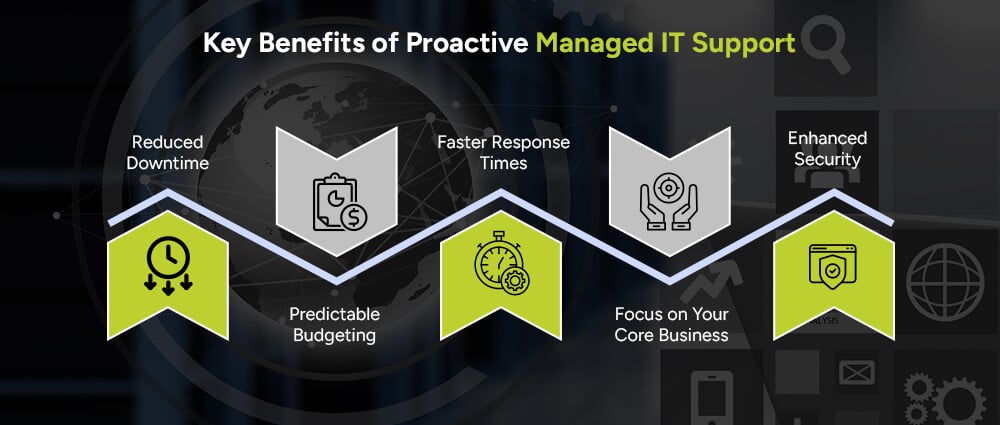
There are many key benefits of managed IT support services, here are some that can elevate the state of your business and take you to the next level:
In a proactive kind of IT support, the upside is that major disruptions are actually prevented by spotting and handling problems before they arise. Instead of waiting for an issue to pop up, IT has an eye on the workability of any aspect of the technology ecosystem, addressing small glitches before they turn into enterprise-wide headaches.
This means lesser crashes, lesser waiting times, and more time to focus on primary work for your team.
Nobody likes surprise and big expenditures usually associated with an unexpected breakdown of IT. Whereas proactive means systems are priced out clearly and remain cost-consistent.
All scheduled maintenance is also within the scope, so thanks to this approach, emergency repair bills or sudden upgrades won’t catch you off guard. When IT expenses are predictable and controllable, budgeting is easy.
When something does go wrong, you don’t want to wait hours, or worse, days, for help. Proactive IT observes the systems 24/7 from the comfort of your house; when there is a suspicious flag raised, someone will immediately attend to it. It means fixed in lesser time, less waiting, and, importantly, more productivity time.
The cost of time and energy involved in maintaining an in-house IT team is quite high, especially for those who are not IT-savvy. With proactive support, the professionals keep everything running smoothly in the background, leaving you and your team with time to grow your business rather than fixing issues with technology.
Cyber threats are constantly evolving, but proactive IT support includes continuous threat monitoring, early detection, and fast response to anything suspicious. It’s like having a digital security guard watching over your business day and night, protecting your data, your clients, and your reputation from harm.
The future of IT support lies in adaptability, security, and intelligence. As companies increasingly rely on digital operations, managed IT services will continue evolving to meet those demands.
Ultimately, managed IT services support is becoming less of a vendor relationship and more of a partnership in business growth.
As technology becomes more complex, the need for smarter, more flexible IT support grows. Managed IT Services Support isn’t just a trend, it’s a necessity for businesses that want to stay secure, agile, and future-ready. By embracing these emerging trends and partnering with the right provider, companies can thrive in the evolving tech landscape of 2025 and beyond.
Managed services bring immense value by providing proactive IT support, minimizing downtime, enhancing cybersecurity, customizing to industries like cybersecurity solutions for healthcare sector, and offering access to expert-level service at a predictable cost. They allow businesses to focus on core goals while leaving the tech management to specialists.
The future of IT support is intelligent, automated, and remote. Trends like tech support automation, AI integration, cloud-based infrastructure, and enhanced cybersecurity will define the next generation of managed medical practice IT support. Personalization and proactive problem-solving will be key.
Managed IT services typically include:
Ramsha Khan
Jul 17, 2025

Why Small Businesses in the USA Need Managed IT Service...
Running a small business in 2025 means balancing everything all at once, from tight budgets, fast-changing technology, to increasing cybersecurity threats. From the startup to maintaining customer satisfaction to keep a workable business, you would rather not have to worry about anything else: security for your systems and backup of your data.
Which is where Managed IT services for small businesses come in. Taking care of all your tech needs, it lets you keep your eyes on growth and not glitches.
Keeping it simple, managed IT services mean outsourcing your company’s technology needs to a dedicated team of IT professionals, also known as Managed Service Providers (MSPs). It can either be fully managed IT services or co-managed IT services. From managing networks to data security, HIPAA compliant cloud storage, hardware support, and 24/7 monitoring, they do it all.
In 2025, IT support for small businesses has become smarter, faster, and more affordable. Thanks to better infrastructure and competition, even startups can now afford enterprise-level IT support.
As your business grows, your once-simple IT setup may start to feel chaotic and hard to manage. Adding more people, tools, and systems can create challenges like:

This is where Managed IT services for small businesses can make a big difference. With affordable managed IT services in the USA, you can get expert IT support for small businesses in 2025 and beyond, helping you reduce costs, fix issues faster, and scale smoothly as you grow.

Here are just a few reasons small businesses are turning to affordable managed IT services in the USA this year:
Hackers aren’t just targeting big corporations anymore. In fact, cybersecurity for small businesses in the USA is now more critical than ever. Ransomware, phishing scams, and data breaches are becoming more common and more costly.
A managed IT team helps monitor your systems 24/7, patch vulnerabilities, and protect sensitive data, so you don’t have to worry about your business being the next target, whether you’re looking for cybersecurity solutions for healthcare, real estate, or any other industry.
Hiring an in-house IT team is expensive. Salaries, benefits, training, it adds up fast. On the other hand, managed IT cost for small businesses is predictable and scalable. You pay for what you need, nothing more.
This is especially useful for startups that have cloud migration and want quality tech support without the overhead. Outsourced IT for startups in the USA is a growing trend because it’s smart budgeting.
Downtime is a killer for small businesses. Lost sales, frustrated customers, and delayed operations can really hurt.
With IT support for small businesses in 2025, proactive monitoring and fast troubleshooting keep your systems running smoothly, so you don’t lose time or money.
Let’s face it: keeping up with technology is tough. With managed IT services, you get access to the latest tools, software development trends, and top-tier expertise, without having to learn it all yourself.
They handle updates, upgrades, and even help with strategic planning for tech investments. That’s a big benefit of managed IT for SMBs looking to stay competitive.
Growing fast? Or maybe you’re a seasonal business that only needs extra support during peak months? Managed IT services scale with you.
That flexibility is a big win, especially for small teams that need to stay lean and agile.
Cloud Managed Services Providers (MSPs) offer more than just tech support; they help small businesses run smarter, smoother, and more affordably. Here’s how:
Whether you’re looking for Managed IT services for small businesses, or are in healthcare IT support services in Dubai, IT support for small businesses in 2025, or affordable managed IT services in the USA, MSPs provide smart, scalable, and cost optimized solutions to help your business thrive.
We do understand that doing anything today feels like a gamble. But in 2025, affordable managed IT services in the USA are more reliable, customizable, and business-friendly than ever.
Think of it as having your own tech department, without the HR headache. Whether you run a small law firm, a local coffee shop, or an eCommerce brand, managed IT services for small businesses make sure you’re supported behind the scenes.
In 2025, ignoring your IT needs is no longer an option. Tech problems aren’t just annoying; they can be damaging. With the right company working on your IT infrastructure, you’ll get the best of services. Whether you’re looking to save money, improve security, or simply get some peace of mind, managed IT services for small businesses are a smart move.
So don’t wait for a crisis to make a change. Start exploring your options today, and let the MSP IT experts at Arpatech handle your tech while you focus on your next big win.
It is easier and cheaper, which is another factor that many businesses are opting for it. Businesses want to grow, not fix technology problems. Managed IT services provide proactive support, excellent security, medical practice IT support, and 24/7 monitoring, which makes it a no-brainer in today’s electronic world.
MSPs are expected to integrate more AI tools, offer enhanced cybersecurity packages, and provide tailored services for niche industries. The focus is shifting from just support to strategic technology partnership. We’re also seeing growth in compliance and remote work infrastructure solutions, and remote managed IT services.
If your business relies on technology (which most do), the time is now. Whether you’re just starting out or scaling up, adopting managed IT early helps avoid costly mistakes, prevents downtime, and gives you peace of mind from day one.
Ramsha Khan
Jul 15, 2025

Cloud Migration? Cost, Process, and Tools: Everything Y...
More and more businesses are shifting their data, applications, and infrastructure to the cloud today. The shift often termed as cloud migration can assist companies in reducing costs, increasing flexibility, and improving overall performance. However, like any major change, it also arises with its own questions and challenges.
In this guide, we’ll walk you through exactly what cloud migration is, what cloud migration strategy is, what a cloud migration plan is, why all the fuss about it, how the process goes down, what cloud migration costs, and all the tools and strategies that will make the whole process easier for you.
Let’s start with a basic cloud migration definition:
Cloud migration refers to digital business operations transfer onto cloud-based infrastructure, say from on-premises servers to applications, data, and IT resources such as AWS, Azure, or Google Cloud. Probably it gets easier by understanding this analogy: moving office files from the hard disk of your computer onto an online folder that you are able to access from anywhere.
Data migration is one part of cloud migration. Cloud data migration is the specific act of moving data, such as files, databases, and digital records, from physical servers or other clouds into your new cloud environment as part of the role of cloud managed services.
Before you move anything, you need a plan. That’s where your cloud migration strategy comes into play.
A cloud migration strategy outlines how you’ll approach the migration in your cloud infrastructure management, what tools you’ll use, what gets moved first, and how you’ll manage risks. It’s like before going on a road trip; you don’t just get in the car and drive. You first plan all your destinations, routes, and stops along the way.
The cloud migration plan is part of your strategy; you can say it’s the most basic first step towards success. While a strategy gives you the big picture, the cloud migration plan focuses on the finer details, like:
When you have a solid plan in place, it ensures that your migration to cloud architecture doesn’t disrupt your business and every operation runs smoothly before and after the switch.
Moving to the cloud is not merely a tech trend but a strategic decision that aids businesses in becoming agile, scalable, and efficient with cost. But how does one undergo this transition? And where should one even start?
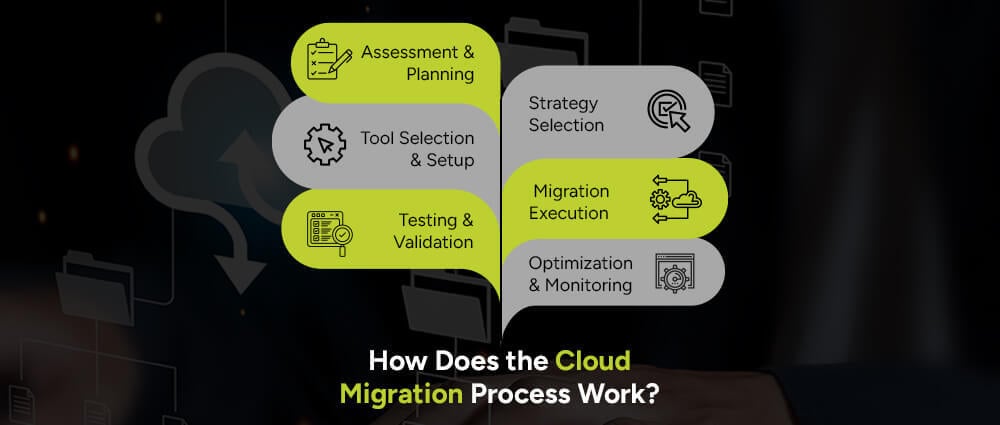
Before even conceiving the idea of migrating, look closely at your existing IT configuration. What applications do you use every day? What sort of data are you storing, and where? Do you want HIPAA compliant cloud storage for healthcare cloud migration, or other compliance storage for other industries?
It is all about understanding the demands of your business and determining what systems are ready to go into the cloud. This is an excellent time for you to identify risks and dependencies. In other words, know what you have available before trying to figure out where you’re going.
Not all cloud migrations are created equal. Depending on your goals, you’ll need to choose the right approach.
Each option has its pros and cons, so think about what’s best for your business in terms of time, cost, and long-term value, and then think about website migration to the cloud.
You don’t have to do everything manually, thankfully! There are many cloud migration tools that can simplify the process.
Some help with data transfer, others with security or performance optimization. Choose tools that match your migration strategy and set them up properly to minimize disruptions.
Now comes the actual move. But don’t start with your most critical systems, dip your toes in first. Migrate less important data or applications as a test run.
This way, you can catch and fix issues before they affect your business. Once confident, continue migrating more essential workloads in phases.
After each stage of the migration, test everything. Are your apps working as they should? Is the data intact? Can your team access what they need without hiccups?
This is your quality control checkpoint. Fix any bugs or gaps before declaring the migration a success.
Migration isn’t the finish line; it’s just the beginning. Once you’re fully in the cloud, you’ll need to keep an eye on performance, costs, and security.
Use cloud monitoring tools to track how everything is running, and adjust resources as needed to get the best bang for your buck.
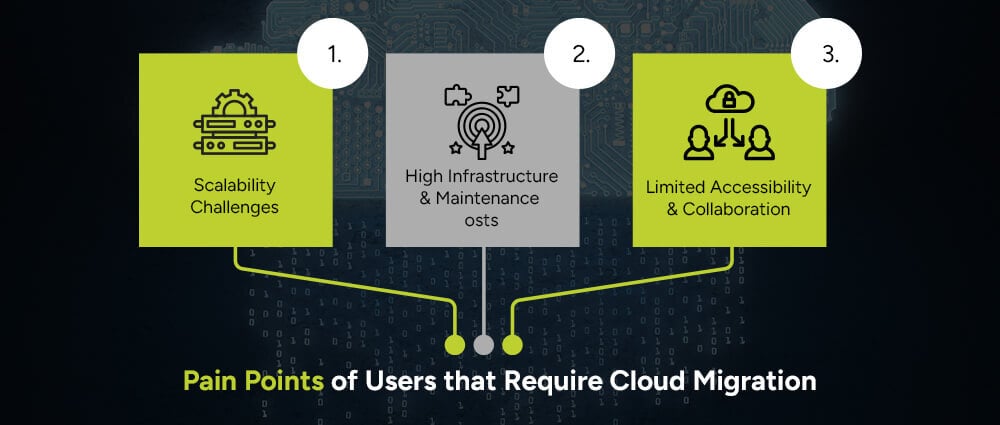
Many businesses start to feel stuck when their existing systems can’t keep up with growth. As more users, data, and apps come into play, their servers start to slow down or crash. This is where cloud migration makes a big difference.
The cloud gives you the flexibility to scale your resources up or down whenever needed, without having to buy new hardware or worry about physical space.
Running servers and maintaining them is expensive. Servers require the procurement of hardware, power, cooling, and IT staff. Moreover, regular maintenance is a requirement. On the contrary, over a certain period, all of this just accumulates in cost and eventually becomes hard to manage, especially for small to mid-sized businesses.
The cloud brings the costs way down. You pay only for what you consume, and extravagant investments in infrastructure are not needed.
With traditional systems, accessing files or tools remotely can be tricky or even impossible. This slows down remote teams and makes collaboration a hassle. The cloud solves this by making your data and apps accessible from anywhere, anytime.
All your teams need is an internet connection, which means better collaboration and more flexibility for everyone.
When moving to the cloud, not all applications and systems need the same approach. Depending on your goals, budget, and how modern your current tech is, you can choose from one or more of these 7 cloud migration strategies:
This is the simplest and fastest option. You just take your existing applications and move them to the cloud without making any changes.
It’s like moving your furniture to a new house without redecorating. Its good for quick migrations and legacy systems.
Here, you move the app to the cloud but make a few tweaks to take advantage of cloud features, like changing the database or upgrading the OS.
You’re still not redesigning the app, just making it cloud-friendlier. You can take advantage of this for apps that need minor improvements.
This means replacing your current app with a new, cloud-based version, often a SaaS solution.
Think of switching from a self-hosted CRM to something like Salesforce. It’s mainly used for standard business apps like CRM, HR, and email.
Refactoring in Cloud Migration means completely redesigning the application to take full advantage of cloud-native features like microservices, auto-scaling, and serverless computing.
It’s more work, but the long-term gains in performance and flexibility are big. Its good for apps with scalability and performance issues. You can watch out for higher costs and longer timelines with this one, though.
Sometimes, you’ll find apps or systems that are no longer needed. Retiring them can save money and reduce complexity.
Before moving everything, take stock and ask yourself if you still need this? It is good for old, unused, or redundant systems.
Some apps might be better off staying where they are, for now. Maybe due to regulatory reasons, performance, or because they’re too complex to move.
In these cases, you retain them on-premise while planning for future migration. Its suitable for critical or complex legacy apps.
This is about moving your entire infrastructure or platform, like VMware, to the cloud without changing any of the apps running on it.
It’s kind of like lifting your whole data center and placing it inside a cloud provider’s environment. This cloud strategy is ideal for bulk moves of virtualized environments
Each of these cloud migration strategies serves a specific purpose, and it’s common to use a mix of them depending on your app portfolio. A thoughtful cloud migration plan and a clear understanding of your goals will help you choose the right combination.
Cloud migration isn’t always smooth sailing. Some of the most common challenges include:
The big question always is: given that it is sensitive data, is it safe to move to the cloud?
One of the biggest fears a company can have is that there might be a data-in-transit issue, data leak, or unauthorized access, or any compliance violation.
Hence security should be there very first in your cloud migration plan: security by encryption, security by access control, and security by audit.
No one wants a black hour with the website or app labelled under construction. But if your migration is not well planned, the under-construction hours might well gain some extra value there.
That means customers can’t access your services, and internal teams might be stuck waiting. A good migration plan minimizes this with step-by-step transitions, good cloud backup services and systems, and lots of testing.
Some older applications don’t play well with the cloud. Maybe, its because they rely on outdated tech, or they weren’t built with cloud in mind. In these cases, you’ll need to either update/ refactor the app or keep it on-premise for now.
Either way, it’s a challenge that needs careful attention, otherwise, you risk breaking critical business tools.
Cloud technology can be complicated, and most companies have no internal expertise to manage it.
Your very own IT department may perform excellently at on-premise systems, but lack the know-how and experience to manage cloud platforms, security policies, and troubleshoot cloud-native issues.
In such scenarios, it is quite often best to engage a qualified cloud services company for assistance.
After initial costing, most companies start questioning their high costs. Many companies go into cloud migration thinking it’ll save money, which it usually does, but poor planning and over-provisioned resources can quickly rack up surprise costs.
Ongoing monitoring and cloud cost optimization are key to keeping things in check. What we are trying to say is that while the benefits of cloud migration are huge, being aware of these challenges and planning ahead can save you a lot of money.
There are plenty of providers out there, but the best IT services company for cloud migration services and cloud consulting are the ones that understands your business needs, has a proven track record, offers tailored solutions, and supports you before, during, and after the migration.
Some examples are:
Look for companies that also help with cloud cost optimization, security, compliance, and ongoing support.
After earning about cloud cryptography and migration, here’s why so many businesses are making the move:
These advantages of cloud migration can give your business a serious competitive edge.
Cloud migration is part of a bigger picture known as cloud transformation. Here are the general phases:
Each phase brings more value to your business.
Cloud migration isn’t just a tech upgrade, it’s a smart move for businesses that want to grow, innovate, and stay competitive. With the right cloud migration company and strategy, tools, and support, the journey becomes smoother and more rewarding.
Ready to take the leap? Let Arpatech’s cloud services work for you, securely, efficiently, and affordably.
The cost of cloud migration depends on the size of your business, the amount of data being moved, your cloud provider, and whether you need to refactor applications. On average, small to mid-sized businesses may spend anywhere from $5,000 to $100,000. But remember, it’s an investment that pays off in efficiency, security, and innovation.
There are seven common approaches in all clouds from multi cloud to hybrid cloud (also called the “7 Rs”):
Once your migration is complete, the real work begins. You’ll monitor performance, adjust resources, manage security, and optimize your cloud setup. You’ll also have the flexibility to build new services and scale as your business grows.
Ongoing optimization is the biggest challenge. After moving to the cloud, businesses often struggle to manage costs, monitor performance, and keep security tight. This is why continuous management and expert support are essential.
Ramsha Khan
Jul 10, 2025

07 Cloud Backup Services for SMEs
Running a small or medium-sized business (SMB) today means juggling a million tasks at once, and securing your data should be one of the top priorities. That’s where cloud backup services come in. They’re not just for big corporations anymore. With affordable, flexible plans and user-friendly tools, cloud backup services are now a smart choice for SMEs too.
But what exactly are these services, and how can they help your business?
Let’s begin with some elementary knowledge: What are cloud backup services?
Simply stated, they store data “off-site,” remotely on secure servers, most of them managed by some third-party vendor. In this case, in the event of a laptop crash or server failures, your data is safely kept in the cloud.
Gone are the days when you would rely on antiquated USB drives or local backups. Cloud storage will give you reassurance knowing your business data is always protected and recoverable. And that is just one of the many advantages that cloud backup services offer, with security, convenience, and accessibility being the more obvious reasons.
While some solutions may be tailored for different SME needs, they really offer enterprise-class cloud backup services. So, one may ask, what is the role of cloud-managed services? Enterprise cloud backup services have the following outstanding features:
These features make modern cloud backup services suitable for businesses that need flexible, secure, and scalable storage options.
In other words, cloud storage is an investment when it comes to cloud infrastructure management, and such effective planning, where one could maximize the benefits of buying space in the cloud, would include the gravity of backup services. It is worth the significant difference it makes in backing up one’s data and recovering it whenever needed. Well, let’s break it down:
This process is what we mean by implementation of cloud backup strategies, a structured approach to using your backup solution effectively and consistently.
So, why are more SMEs are ready to migrate to cloud architecture and investing in the cloud? The advantages of cloud backup services go beyond just convenience:
In short, the benefits of cloud backup services make them a no-brainer for SMEs that value their data.
Despite the many perks, it’s important to be aware of the challenges of cloud backup services:
Understanding these risks helps you prepare better and choose smarter.
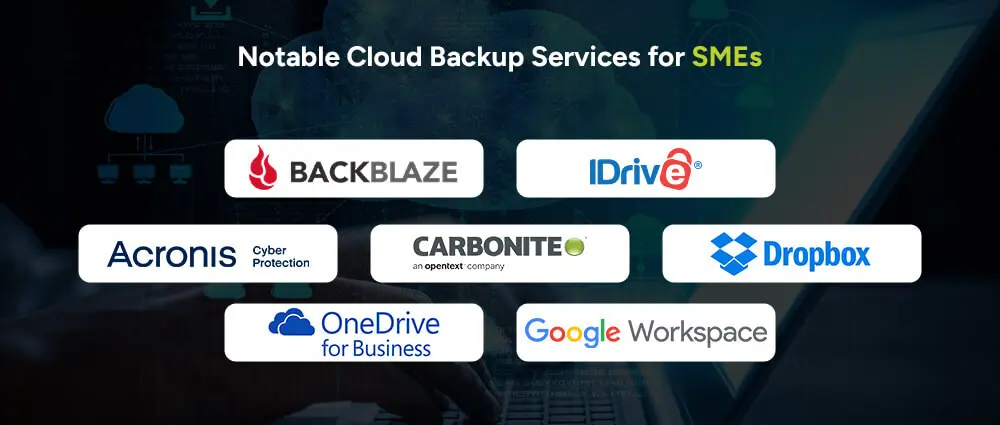
Now let’s look at seven notable cloud backup services used by SMEs around the world:
An easy-to-use service, Backblaze has a single low monthly fee for unlimited cloud storage for one computer. Backblaze is a great option for small companies that value stress-free backups without any hidden charges.
IDrive allows you to not only backup data into the cloud but also onto your local device. Hence, you get double protection for your files. This tool is best for businesses that desire an excellent backup proposal with added security.
Acronis not only works with backups but also protects from cybersecurity threats like malware and ransomware. Perfect for SMEs that want data backup and solid security capabilities.
Easy to set up with automatic and uninterrupted backups are the hallmark of Carbonite so that your files keep being saved regularly without you ever having to remember anything. Perfect for teams with little tech savvy.
This application works on the familiar Dropbox platform and saves multiple versions of your files automatically and in the background. Great for groups already using Dropbox for team collaboration.
OneDrive works seamlessly on Microsoft 365 apps such as Word and Excel, thereby making storing and accessing work documents quite easy. It’s a smart pick for companies already using Microsoft tools and require HIPAA Compliant Cloud Storage.
Google Workspace Backup (via Spanning):
This service backs up Gmail, Google Drive, Calendar, and Docs, so your Google Workspace data stays safe. It’s especially useful for SMEs that run daily operations through Google apps.
Each service brings its own unique value depending on your storage needs, team size, and risk tolerance.
Whether youre going for Public Cloud vs Private Cloud vs Hybrid Cloud, If you’re based in the UAE or the surrounding region, these best cloud backup service providers offer localized expertise and globally competitive solutions:
An innovation-based tech firm delivering secure, scalable cloud backup services customized for SMEs. Their solutions include website migration to cloud, automated backups, storage management, and disaster recovery support.
Known for innovation and user-focused design, Tekrevol provides cloud-based backup solutions that scale with your business, along with cybersecurity and cloud consulting services.
A global IT powerhouse that also offers SME-friendly data backup solutions, including regulatory-compliant storage, business continuity, and cloud migration services.
As one of the oldest IT firms, Systems Limited provides trusted enterprise cloud backup services to small and mid-size businesses, including storage configuration, hybrid backups, and full disaster recovery tools.
These firms are great choices for SMEs looking for trustworthy and scalable solutions.
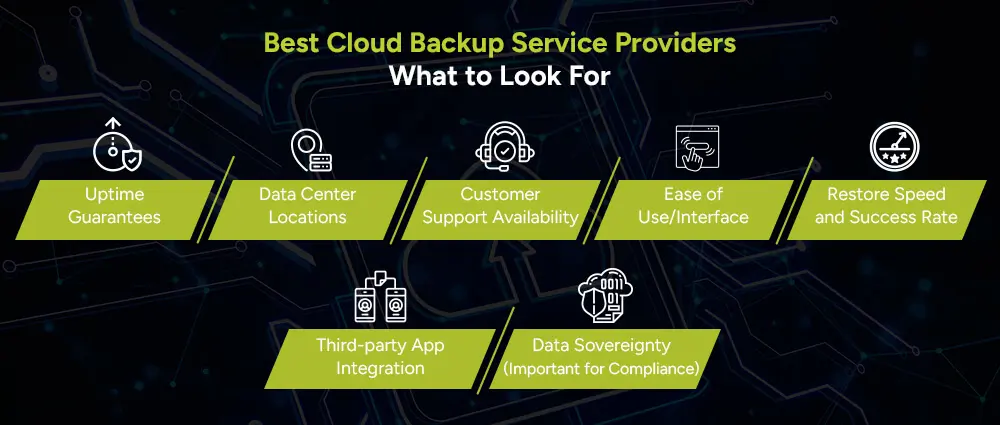
When choosing among the best cloud backup service providers or cloud consulting companies, always consider:
Look for providers that promise 99.9% or higher uptime to ensure your data is always accessible.
Choose a provider with data centers close to your region for faster access and better compliance with local laws.
Reliable 24/7 support is essential in case you face issues or need urgent help with your backups.
A simple and user-friendly dashboard makes it easier to manage backups without technical hassle.
Fast and reliable data recovery ensures your business can bounce back quickly after data loss.
Make sure the service connects smoothly with tools like Microsoft 365, Google Workspace, or Slack.
Ensure your data is stored according to your country’s privacy laws and compliance requirements.
Choosing the right provider means looking beyond price and focusing on value, security, and usability.
For SMEs, cloud backup services are no longer optional; they’re essential. Whether you’re running a small team or scaling fast, having a proper backup strategy is key to business continuity, especially in today’s hybrid work environment.
Understanding what cloud backup services are, their key features, and how to implement cloud backup strategies with backup services will empower your business to grow securely and confidently.
With options like Arpatech, the Middle Eastern SME sector has access to world-class solutions customized to all local and international requirements.
The time to protect your data is now, because once it’s gone, it may be gone forever.
Your cryptography It depends on your business needs. For SMEs, the best global tools are Google Drive and Dropbox Business. For the provider, you can contact Arpatech as the cloud backup service provider.
There is cloud cost optimization, but prices vary. Google Drive offers 1TB for around $10/month. Business-focused platforms may charge more depending on features like security, support, and scalability.
Absolutely. Compared to the cost of losing customer data, project files, or financial records, cloud backups are a small investment for big peace of mind.
Yes! You can subscribe to services like Google One, iCloud, or business providers like Dropbox, or even set up a private cloud if you have the technical know-how.
Ramsha Khan
Jul 8, 2025

Smart Finance and accounting BPO services for Growing S...
Managing finances can be tough, especially for small and medium-sized businesses (SMBs) where resources are limited, and every decision can have a big impact. Whether you’re just starting out or looking to streamline your growing operations, getting your finances in order is crucial. That’s where finance and accounting BPO services come in.
But what does that really mean? Let’s break it down in simple terms and explore how outsourcing your financial processes can help you grow smarter.
Think of Business Process Outsourcing (BPO) for accounting as: a helping hand with your finances. Rather than hiring and managing a complete accounting team in-house, you simply engage a trusted partner to handle the numbers on your behalf.
Anything from regular bookkeeping, payroll management, financial reporting, or tax preparation, these professionals are equipped with the tools and expertise to do everything. The best part? You would rather spend time growing your business than handling spreadsheets.
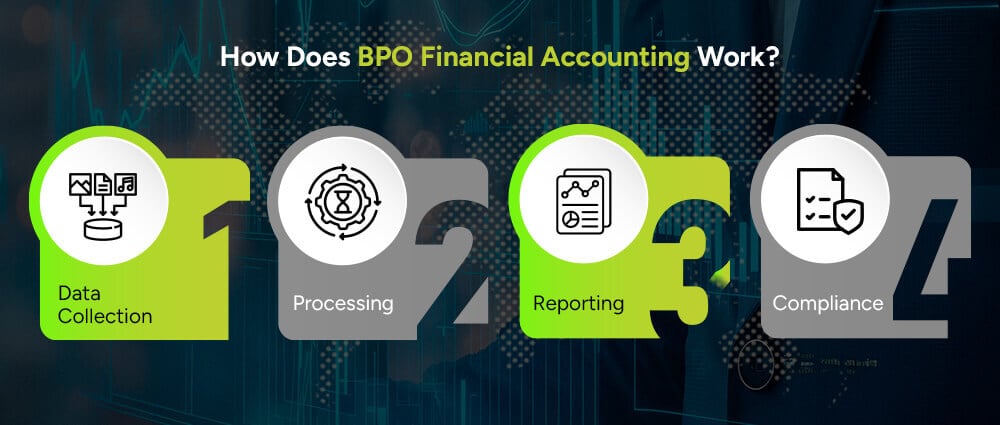
The finance and BPO accounting process typically starts with an assessment of your current setup. The service provider will look at your existing tools, reporting needs, and financial workflow. Then, they’ll create a customized plan to manage these tasks efficiently.
Here’s a breakdown of how this process typically works:
This is the foundation of the process. All financial actions need to be accounted for accurately hence, the BPO partner begins their work by collecting your financial papers. These will typically include invoices, receipts, sales figures, payroll, expense reports, and bank statements.
Most of the time, this process is automated through secure, cloud-based systems, thereby reducing manual errors and speeding up the collection. Contemporary finance and accounting BPO services have also started embracing your existing tools such as QuickBooks, Xero, or ERP systems so that you do not need to make a transformation on your current setup.
The next step after gathering data is organization and analysis. Applying sophisticated finance and accounting applications, a BPO specialist analyzes your financial information into structured formats. That means updating ledgers, classifying expenditures, controlling account payables and receivables, and reconciling.
Automation plays a key role here, with many leading finance and accounting BPO services utilizing AI-enabled tools for anomaly detection and trend identification to boost efficiency and accuracy.
Now that your data is clean and well-organized, the BPO team’s next job is to generate reports that give you real-time visibility into your finances. These can range from simple cash flow summaries to detailed profit and loss statements, balance sheets, budget vs. actuals, and forecasting models, enabling you to ultimately get a better revenue cycle management.
These reports are crucial for making informed decisions about spending, investing, and scaling your operations.
Compliance must be taken on strict priority. The gravest advantage of finance and accounts BPO services is being supported by professionals conversant with local laws as well as international ones in regard to finances.
From tax returns to audits, it is ensured that the records are compliant under the law. Every possible chance of being penalized, missing deadlines, or being subject to audits is considerably lessened. In some industries, like e-commerce and healthcare outsourcing services, it is a matter of the implementation of certain financial reporting standards; your BPO provider will assure that the standards are implemented to the letter.
So, how does BPO financial accounting work? It works by creating a smart, no-hands system that handles your day-to-day accounting needs while keeping everything clean, compliant, and ready for growth.
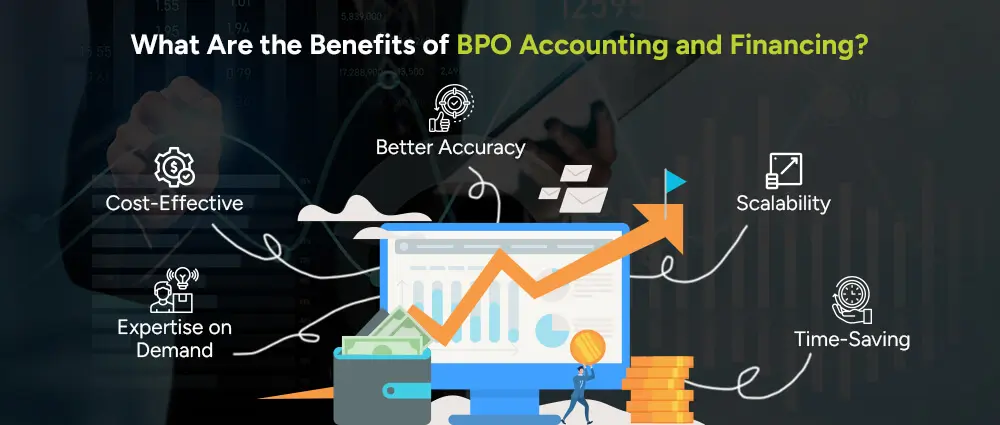
For small and medium-sized businesses, partnering with a BPO provider offers more than just convenience, it delivers strategic BPO advantages that can help transform your business. Let’s dive deeper into the benefits of BPO accounting and financing and why it’s such a valuable move.
Hiring, training, and maintaining an in-house finance team can put a strain on your budget, especially when you’re a growing business. With IT outsourcing price models and finance and accounting BPO services, you pay for exactly what you need.
There’s no overhead cost for office space, software licenses, or employee benefits. You can scale up or down based on your business cycles, making it a far more flexible and affordable option. In short, you get expert service without the expense of a full-time team.
One of the major challenges for any SMB is finding seasoned finance professionals. BPO already has accountants, analysts, and compliance experts entrenched in the business. They are industry-trained and exposed to the most sophisticated finance and accounting tools, so they can adapt very quickly to your specific needs.
From processing payroll to tax compliance and complex financial forecasting, you will have access to the right people with the right experience, but without a long hiring process.
Human error is one of the leading causes of financial discrepancies in small businesses. By outsourcing, you’re relying on teams that follow strict quality control procedures and use modern automation to reduce manual entry.
The finance and accounting business process integration includes checks and balances at every stage to ensure data accuracy. This leads to better decision-making and fewer issues during tax season or audits.
As your business grows, so do your financial needs. A small team that was managing well when you had 10 clients may become overwhelmed when you reach 100. BPO services are designed to grow with you. Need more frequent reporting?
Complex multi-currency accounting? Support for a new office? Your provider can adjust the service without you having to hire and train more people. This kind of built-in scalability gives you the flexibility to grow without financial bottlenecks.
Time-consuming money management leaves no space for multi-operational roles a business owner must often juggle. Gaining time again through even data entry outsourcing services to a trusted partner allows much more focus toward innovation, strategy, and customer relationships.
Now you can have a clear advantage from finance and accounting back office services, which is the fact that you are not stressing over tax deadlines or being buried under a stack of spreadsheets anymore. You’re working on your business, not in it.
We offer some of the best finance and accounting BPO services tailored for small and medium businesses. Whether you need help with bookkeeping, financial planning, or tax compliance, our team is here to handle the numbers while you focus on building your business.
Our services include:
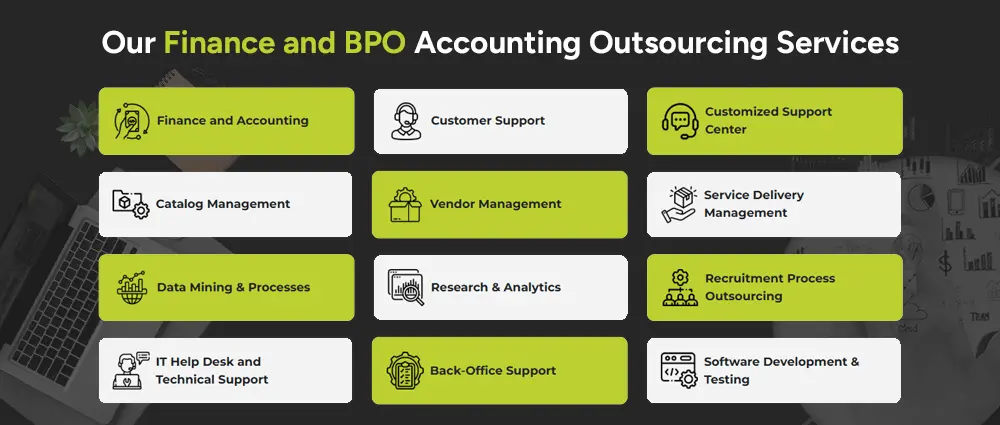
All of this is powered by the latest finance and accounting tools, ensuring speed, security, and accuracy.
Outsourcing your finance tasks to professionals offers a clear advantage for finance and accounting back office services. You get a dedicated team without the overhead costs of hiring and training.
Plus, you get peace of mind knowing your finances are handled by experts who follow industry best practices and compliance standards.
Outsourcing your financial operations doesn’t mean giving up control, it means gaining the support you need to manage your business better. With the right finance and accounting BPO services at Arpatech, small and medium-sized businesses can improve accuracy, save money, and grow with confidence.
For a free consultation, contact the experts today!
A financial accountant in BPO deals with different activities regarding the finances of a company. Activities like data entry outsourcing, keeping financial records, preparing reports, reconciling accounts, processing payroll, and adhering to compliance regulations. They act as a virtual finance department for your business.
The cost depends on the size of your business, the complexity of your financial needs, and the services you require. Typically, BPO services are more affordable than hiring a full in-house team. Most providers offer flexible pricing models, either fixed monthly fees or pay-as-you-go options, depending on what fits your business best.
Ramsha Khan
Jun 26, 2025